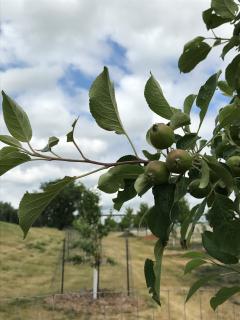Community Orchards Branching across North Dakota
Photo Credit: Kathy Wiederholt, NDSU
Tuesday, July 24, 2018
Guest post from North Dakota Forest Service's Community Forestry Program in coordination with the Western Urban and Community Forestry Network's #HealthyTreesHealthyLives social media campaign. Explore the hashtag #HealthyTreesHealthyLives on social media to learn more.
 Consumer demand for healthy, locally grown foods has resulted in development of community orchards across North Dakota. This project fosters community spirit by bringing people together to plant and nurture the orchards, and by providing fresh food for schools, residents, and those in need.
Consumer demand for healthy, locally grown foods has resulted in development of community orchards across North Dakota. This project fosters community spirit by bringing people together to plant and nurture the orchards, and by providing fresh food for schools, residents, and those in need.While apples remain a favorite, a surprisingly wide variety of fruits can grow and produce abundant harvests in the northern plains. Since 2006, the Northern Hardy Fruit Evaluation project at NDSU-Carrington has evaluated both common and unusual crops to determine selections that are desirable, hardy and productive in North Dakota.
Hardy cultivars of cherries, plums, pears and peaches are now common North Dakota orchard fruits. Fruit-bearing shrubs including Aronia and currants are gaining popularity for their high nutritive value. While blueberries cannot thrive in North Dakota’s alkaline soils, honeyberries (Lonicera sp.) have proven to be a sweet and tasty replacement.
Local consumers enjoy fruit fresh and a handful of commercial wineries across the state have learned to make use of the fruit, too.
The North Dakota Department of Agriculture has enabled dozens of community groups and schools to plant gardens and orchards with ND Community Orchard grants with awards up to $7,500. Additional funding from the ND Forest Service supports many of the same plantings.
Valley City converted barren lots into the Hi-Line Prairie Gardens and Orchard Project. With the support of an America the Beautiful Program Development grant from the ND Forest Service, a master plan was developed for the 4-acre site. Located adjacent to a sports and recreation complex and within blocks of schools, a nursing home and assisted living facilities, the location has evolved into an attractive, colorful retreat with community and educational value. The orchard features 52 different fruit-producing trees and shrubs and is the result of the collaborative efforts of the city, local beautification and Boy Scout groups, and Valley City State University. In pay-it-forward fashion, volunteers from the Valley City project helped establish a community orchard in a vacant lot in nearby Litchville.
To learn more, contact Gerri Makay, Community Forestry Program Manager, North Dakota Forest Service at Gerri.Makay@ndsu.edu or 701-652-2951.
Reference: NDSU H-1558, “Starting a Community Orchard in North Dakota”
Photo Credit (top left): Mary O’Neill, NDFS, (bottom right) Gerri Makay, NDFS